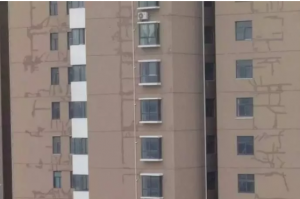How should we deal with and prevent cracks
date: 2020-02-12 15:31:29Source: RG JIAYEViews: 958

During the use of the house, we will pay special attention to the interior decoration and try not to damage it, but the outer wall is the one we most easily overlook. After years of use, cracks in the wall of the external wall will inevitably occur. The cracks in the wall not only endanger our lives, but also affect the overall beauty of the house. We need to crack the external wall at this time. Repair, let’s learn it together.
The health of the house is also one of the issues we need to pay attention to, and among many problems, cracks in the external wall are one of the problems that many owners do not know what to do. Today, I will introduce to you how to deal with cracks in external walls and how to prevent cracks. Come and find out.
How to repair leaking cracks in external walls
1.How to repair the leakage of cracks in the outer wall caused by design factors, and waterproof treatment. It is an important quality factor in house construction. When designing its building, it is necessary to consider the differences in the performance of waterproof materials and the climate in the north and south. Therefore, the waterproof design of a building needs to understand its certain complexity. As long as the problem of waterproof design of the project occurs, it is likely to cause leakage of the external wall of the building. In view of this situation, if you want to completely solve the leakage problem, it is to re-waterproof, but it takes time and effort, the capital investment is too large, and it is often not realized in practice.
2. Once there are tiny cracks in the outer wall tiles and ash joints, use a penetrant to apply vertical brushing treatment to the cracks within a range of 0.3 meters above and below. Each crack should be treated no less than 2 times, and the wall surface must be dry before treatment.
3. Waterproof powder for exterior wall and JS composite waterproof coating are mixed into a repair paste according to a ratio of 3.5: 1, and the cracks between the tiles are filled. When the exterior wall is dry, spray the exterior wall fully with a silicone water repellent. Organic silicon water repellent is an environmentally friendly product, it will not change the original color of the wall, it is not easy to stick to dust, and it will not affect the decorative effect of the decorative brick.
How to prevent cracks in external walls
1.For the blockage of scaffolding, the more effective method is: first rinse the debris in the scaffolding eyes with water, and then use a 1: 2 cement mortar to lay the half brick to the inside of the scaffolding eyes. The gray seams should be blocked and full, and thin steel plates can be used. Tamp, then use C30 fine stone concrete to fill the outside of the scaffolding eye, penetrate the wall to 10mm outside the wall, the concrete should be mixed with 5% -8% of water-proofing agent or micro-expanding agent, and after drying, use 1: 2 The cement mortar and the wall are smoothed and calendered. Although there are many procedures in this treatment, it has a significant effect on preventing water leakage from the external wall.
2. Masonry mortar fullness The “Specifications” stipulates that “the horizontal gray seam fullness of hollow brick masonry should not be less than 80%, and the vertical gray seam should be filled with mortar, and there should be no transparent joints, blind joints or false joints.” The consistency of the masonry mortar should be correctly selected according to the hollow masonry, and the ratio should be calculated and adjusted by trial. The “trinity” method is used for masonry, and “dry bricks on the wall” are strictly prohibited. The bricks should be watered and moistened before construction.
3. At the joint of each layer of reinforced concrete ring beam and masonry, add an outer wall of 15m and an inner wall of 30mm. The wall has a scalloped barrier mortar layer, the mortar ratio is 1: 3, and the content is 3%. Waterproofing agent is then poured into the concrete ring beam. The specific construction method is: after the masonry is built to the top and watered, then the impervious mortar layer is laid, and the surface is paved with the calender. After 24 hours curing at room temperature, the impervious mortar layer can reach a certain strength before Carry out the rebar bundling and formwork operations in the next steps. After treatment, water can be effectively prevented from leaking along the wall from high to low. If leakage occurs, only leakage points will appear on this floor.








